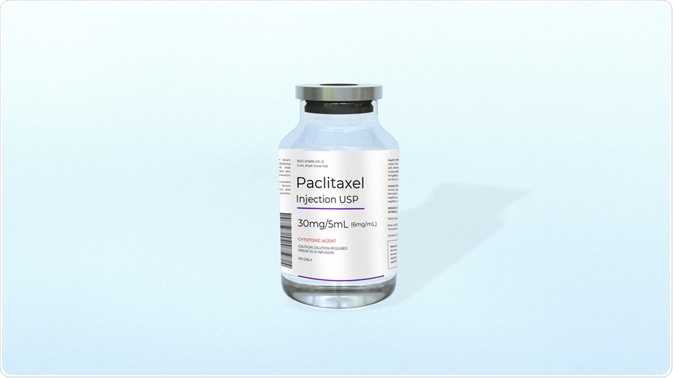Throughout the development of paclitaxel, which is one of the most successful anticancer drugs of the past 50 years, adequate supply has remained a major challenge. This drug has been very complex to synthesize economically from first principles and cumbersome to isolate from natural sources. In addition, paclitaxel represents only a minor proportion of the total taxoid content of the Taxus species.

Image Credit: nudelman / Shutterstock.com
The first commercial company to accomplish large-scale production of paclitaxel was Polysciences, Inc. Clinical trials were possible when a methodology was derived to extract a precursor of this drug, 10-deacetyl-baccatin III, from the common evergreen yew tree Taxus baccata, which is often found in people's gardens. By chemical synthesis procedures, the precursor was subsequently converted to paclitaxel.
Methods of paclitaxel production
Since the discovery of paclitaxel, a sustainable increase of its extraction was the principal goal of the pharmaceutical industry. A serious obstacle is the aforementioned low proportion of paclitaxel, even in the most productive species, Taxus brevifolia (0.001-0.05%). Consequently, the treatment of one cancer patient consumes approximately eight 60-year old yew trees.
A similar situation arises with other Taxus species as well, such as Taxus chinensis. According to the report from CEC China Pharmaceuticals Ltd., 10 thousand kilograms (kg) of leaves and bark from this species are required to isolate 1 kg of paclitaxel.
Advanced and often expensive technologies and complex purification techniques are needed for such extractions, which is the reason why ecological harvesting protocols are being developed. Atlantic Forestry Centre, for example, converts elite cultivars of the wild species into a commercially usable crop. In 2004, the company Yewcare began to plant Taxus chinensis in the Chinese provence of Yunan, currently covering more than 30 km2 in monoculture.
The chemical synthesis of paclitaxel was first achieved by Holton and Nicolau in 1994; however, the low yield limit combined with the complexity of its biosynthesis hampered its applicability. An alternative approach is producing paclitaxel by semisynthesis through the use of intermediates from the needles of the European yew.
Plant cell cultures represent an alternative and environmentally sustainable source of paclitaxel. Some advantages of this method include the growth of the material that is independent of its original location, thus preventing these materials from being subject to seasonality or weather. The selection of cell lines, along with the addition of precursors or optimization of culture conditions are strategies that have been shown to increase paclitaxel yield in plant cultures. At the moment, Python Biotech is the largest producer of paclitaxel by this method.
In 1993, an endophytic taxol-producing fungus was found in Taxus; however, fungal fermentation was shown to give low yields of paclitaxel. Nevertheless, Cytoclonal Pharmaceutis, Inc. patented the process and, in 2001, signed a contract with Bristol-Myers Squibb for the development of new methodology based on microbial fermentation for paclitaxel and other new taxane therapeutics.
Demand, profits, and future approaches
At the end of last century, worldwide sales for paclitaxel produced by Bristol-Myer Squibb climbed up to 1.5 billion dollars. It should be noted, however, that there has been a decrease in sales in recent years, which is mainly due to patent expiration and increased generic production of the drug in both Europe and Japan. The total market for paclitaxel remains well above 1 billion per year with continued expansion.
Suprageneric versions of paclitaxel were developed, such as nanoparticle albumin-bound paclitaxel (Abraxis Oncology's Abraxane) and polyglutamate paclitaxel (Cell Therapeutics' Xyotax). Their advantages are in terms of drug delivery and a lower number of side-effects. Their sale growth remains steady, reflecting a growing market for paclitaxel and other derivatives of Taxus species.
In order to improve the yield of paclitaxel and other taxanes in cell cultures, efforts have been focused on assaying the biosynthetic activities of cultured cells. Some of the approaches include screening of high yielding cell lines, optimization of cultural conditions and production media, induction of secondary metabolite pathways, and the use of a two-phase culture system. Future perspectives should be concentrated on the simultaneous use of empirical and rational approaches.
References
Further Reading
Last Updated: Apr 22, 2021